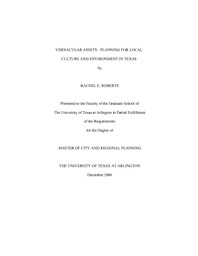
ATTENTION: The works hosted here are being migrated to a new repository that will consolidate resources, improve discoverability, and better show UTA's research impact on the global community. We will update authors as the migration progresses. Please see MavMatrix for more information.
Show simple item record
| dc.contributor.author | Roberts, Rachel E. | en_US |
| dc.date.accessioned | 2009-09-16T18:20:08Z | |
| dc.date.available | 2009-09-16T18:20:08Z | |
| dc.date.issued | 2009-09-16T18:20:08Z | |
| dc.date.submitted | January 2008 | en_US |
| dc.identifier.other | DISS-10079 | en_US |
| dc.identifier.uri | http://hdl.handle.net/10106/1824 | |
| dc.description.abstract | This paper examines how fast-growing cities in Texas with populations over 100,000 plan for local cultural and environmental resources. In the face of globalization, cities in the United States attempt to craft unique identities for themselves in order to attract tourists, residents, and footloose capital, but plans are often borrowed from work in other cities or are forms of Disneyfication and lead to increasing homogenization among cities. This paper argues that planning based on vernacular assets can better shape local identity, with vernacular assets defined as local cultural and environmental resources that are rooted in place. Plans and related documents from eight fast-growing cities were evaluated in terms of how or if they protect or develop vernacular assets. The paper concludes that, although the cities do protect some vernacular assets, these resources are not generally used as a framework for planning or for developing local identity. | en_US |
| dc.description.sponsorship | Grodach, Carl | en_US |
| dc.language.iso | EN | en_US |
| dc.publisher | Urban & Public Affairs | en_US |
| dc.title | Vernacular Assets: Planning For Local Culture And Environment | en_US |
| dc.type | M.C.R.P. | en_US |
| dc.contributor.committeeChair | Grodach, Carl | en_US |
| dc.degree.department | City & Regional Planning | en_US |
| dc.degree.discipline | City & Regional Planning | en_US |
| dc.degree.grantor | University of Texas at Arlington | en_US |
| dc.degree.level | masters | en_US |
| dc.degree.name | M.C.R.P. | en_US |
| dc.identifier.externalLink | http://www.uta.edu/ra/real/editprofile.php?onlyview=1&pid=1850 | |
| dc.identifier.externalLinkDescription | Link to Research Profiles | |
Files in this item
- Name:
- Roberts_uta_2502M_10079.pdf
- Size:
- 1.229Mb
- Format:
- PDF
This item appears in the following Collection(s)
Show simple item record


